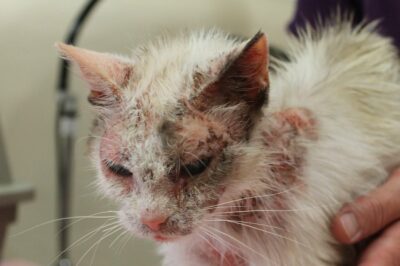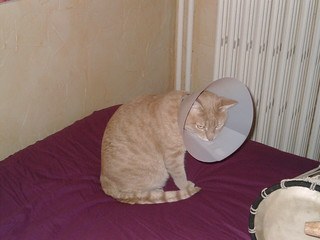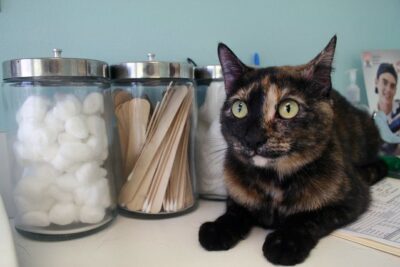To treat itchy skin in a cat, or what a vet calls “pruritus,” the focus of treatment amounts to finding the underlying cause and eliminating it.
The most common reason for itchy skin is due to some kind of allergy. Allergies are hypersensitive immune responses to irritants found in the air, food, or other substances. Allergens, or irritations that cause an allergic reaction, can include dust, pollen, food additives, some food proteins, fleas, venom from bee stings, and household cleaning products.

Itching will emerge as only one of many possible responses. Others include hair loss, breathing difficulty, skin redness and irritation, swelling, coughing or sneezing, vomiting or diarrhea, runny eyes or nose, and chewing at the paws or tail.
Cats can have an allergic reaction to many things, making it difficult to isolate the cause of the cat’s allergy. This list will give you common ones:
- Pollen, which can come from trees, dust, grass, and weeds.
- Food: Represents the third most common cause, and can include many types of food. Most common might surprise you–animal proteins such as chicken, beef, dairy, fish, and eggs
- Fleas: These can cause problems for both indoor and outdoor cats
- Medications
- Household cleaning products
- Perfume
- Cigarette smoke
- Various surfaces, such as certain fabrics, rubbers, or plastics.
Looking Closer At The Causes Of Allergies
These causes will usually show up as inflammatory in nature. Kitty’s immune system can over-react when she comes into contact with an allergen, either through inhalation or ingestion. The result: Skin inflammation and itchiness.
Infectious causes can fall into these categories:
- Ringworm (dermatophytosis): A most common infectious cause. Since ringworm can be transmitted to humans, this test thus becomes most important.
- Parasitic Infection: Such infestations can cause itchiness. These parasites include fleas, ticks, mites, or other organisms. Please note that an indoor cat can also contact fleas, so this possible cause must be investigated. If fleas appear, treatment must go into effect. In over 50% of itchy cat cases, fleas are present
If the cat itches on the back half of the body, especially near the base of the tail, the reason could well point to fleas.
Inflammatory Causes
Food allergies: Cause of these allergies usually stems from proteins such as chicken or fish. Surprisingly, grain allergies show up only in extremely rare cases.
Food trials, typically lasting eight weeks, furnishes one of the best and most cost-effective ways of evaluating food as a source of allergic reaction.

During a food trial, the cat eats only a hydrolyzed diet. This diet consists of prescription foods that cannot cause an allergic reaction because the proteins in the food have been broken up into such small pieces, or amino acids, that the immune system does not recognize them as foreign proteins. Thus, no allergic reaction becomes triggered.
After eight weeks, the vet will reassess the itch level. If the diet causes dramatic improvement that quickly returns with the introduction of another diet, a food allergy is causing the itching.
If such becomes the case for your cat, you should feed him either a hydrolyzed protein diet or a novel protein diet (protein source that is new to the cat) for the rest of his life.
Environmental Allergies
These occur when a cat inhales allergens. Discovering the cause of these allergies involves the use of intradermal testing. In this process, as with people, small amounts of dozens of common potential allergens are injected under the skin (using sedation or anesthesia), then visually inspecting the skin’s reaction to each.
This form of testing comes into use if the pet owner wishes to pursue allergy shots.
Flea Bite Hypersensitivity
This one is the number one cause of skin diseases in both dogs and cats. Since it only takes a few fleas to cause a dramatic level of itching, the goal in treatment becomes getting rid of 100% of the fleas.
Contact Allergies
Though rare, these can occur when the cat comes in contact with a potential allergen. An example: Cat litters of a certain kind. Also, certain fabrics, dyes, cleaning materials, plastic, or plants can cause contact allergies.
What Can You Do To Help Alleviate Itching?
Try these ideas to help reduce itching:

- Give a calming bath. Warm water can soothe the skin. It will wash away scabs, dandruff, pollen or dust, or other debris on the skin.
- Make sure the air in your house contains sufficient moisture. If the air is too dry, it could cause itchy skin.
- Use a cat shampoo, not a human shampoo. Cat shampoos have ingredients to help moisturize the skin, thus reducing itching.
- In chronic cases, antihistamines might help, but not a lot. Consult a vet first.
- Use a cone to keep kitty from scratching. Try the cone for about a week to see if it reduces itching.
What Treatment Techniques Do Vets Use?
1) Antibiotics, oral or topical
2) Antifungal products for yeast infections

3) Steroids or hyposensitization therapy, or food trials
Ways To Keep Your Cat Away From Allergens
1) A life-long flea and tick prevention is most important, even if the cat never goes outdoors.
2) Primrose and fish oils: These methods, inexpensive and safe, can provide minimal relief.
3) Probiotics: Emerging evidence shows the daily use of probiotics can help with some itchy skin problems.
4) Keep your cat inside if the pollen count in your area becomes high.
5) Remove your shoes when entering the house, as this will reduce the amount of pollen brought into your dwelling.
6) Filter the air in your home to keep pollen out.
7) Make that bath a weekly event.
8) If your cat goes outside, give him a rinse when he returns home.
9) Topical hydrocortisone creams and salves can reduce irritation by being applied directly to the skin.
10) Ask your vet about natural remedies available for cat skin problems.

11) Feed your cat a lot of fatty fish, such as salmon and tuna. The omega 3 fatty acids help reduce the effects of chemicals released during an allergic reaction.
Your vet may have other treatment suggestions, such as using antihistamines. Perhaps he will want you to try cyclosporine. He might also prescribe corticosteroids. These may provide relief from inflammation and itching. Perhaps the vet will suggest allergy shots.
The most important thing: Determine the cause of the allergy, and then treat the underlying condition. This is the key to breaking the allergy cycle.
References I used for this post: hillspet.com/cat-care/healthcare/cat-food-allergies-and-intolerance petmd.com/cat/conditions/skin/cat-skin-allergies wikihow.pet/treat-seasonal-allergies-in-cats petmd.com/cat/symptoms/skin/why-your-cat-itchy-and-what-you-can-do thesprucepets.com/allergies-in-cats-4775181


Our Sunspot had allergy testing done with a blood test. He was on the hydrolyzed diet for a bit but snuck food from the other cats and didn’t seem to suffer so we considered foods ruled out.
Turns out he’s allergic to a lot of weeds, grasses and trees, wool, people, molds, dust, fleas, house flies and roaches. We’re going to be treating him for the weeds, the bugs, dust and the mold.
In the meantime he takes some of Treeno’s Zyrtec when we travel so his eyes aren’t all swollen and red in the show hall or whenever he seems extra miserable.
Good to hear the path you’ve followed to find out your kitty’s allergies. Perhaps your answer will be helpful to other people. It’s quite a process to get it all figured out. Good for you for doing such a thorough job.